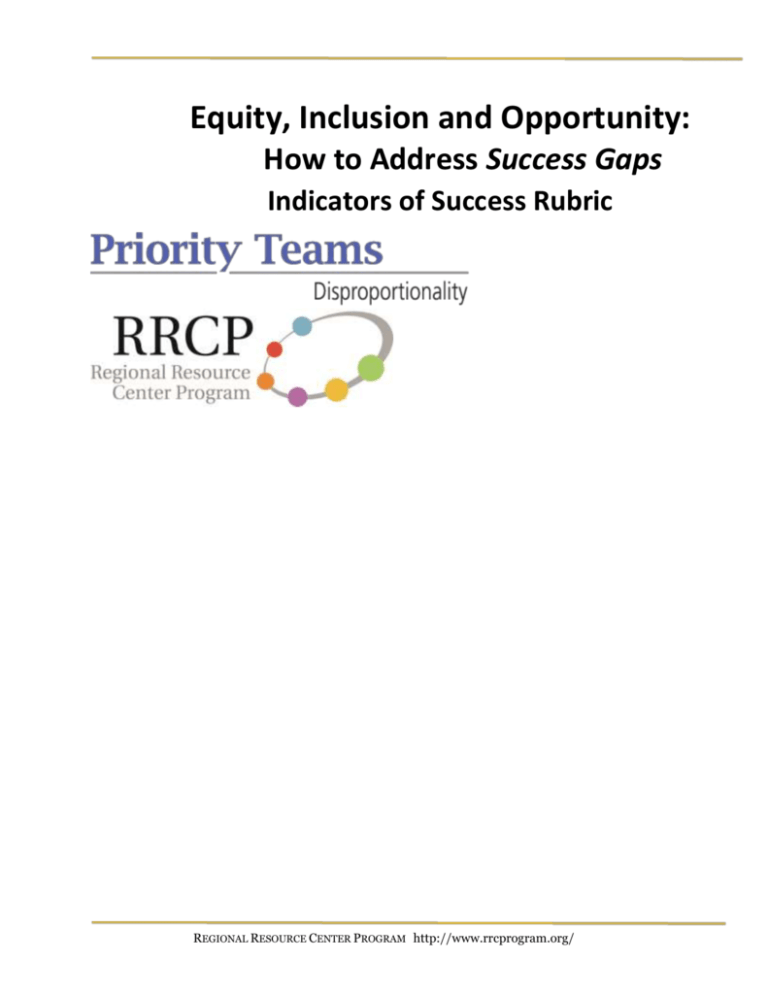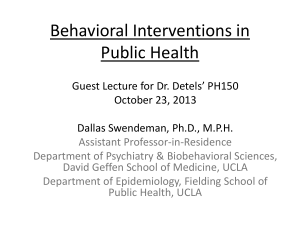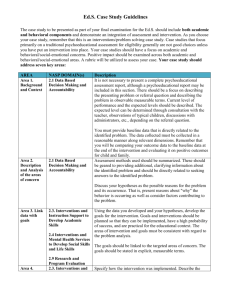Equity, Inclusion and Opportunity: How to Address Success Gaps
advertisement

Equity, Inclusion and Opportunity: How to Address Success Gaps Indicators of Success Rubric REGIONAL RESOURCE CENTER PROGRAM http://www.rrcprogram.org/ Equity, Inclusion and Opportunity: How to Address Success Gaps Indicators of Success Rubric Indicator Planning Partially implemented Implemented Exemplary Data-based decision making Probing Questions: Does our school or district identify data elements or quality indicators that are tracked over time to measure school effectiveness? What are those data elements? Are the data valid and reliable? Are data disaggregated by student demographics such as race/ethnicity, gender, disability etc. to identify gaps in achievement and performance and trends with over- or under- representation in identification, placement and discipline? Are data reviewed at regular intervals to determine progress or change? Are data used to make policy, procedure and practice decisions in your school? How regularly do we use this data to inform our decisions? Decisions about the school curriculum, instructional programs, academic and behavioral supports, and school improvement initiatives are based on data Decisions about the school curriculum, instructional programs, academic and behavioral supports and school improvement initiatives are rarely based on systematic data. Some teachers and programs consistently use systematic valid and reliable data to inform decisions about curriculum, instructional programs, academic and behavioral supports, and school improvement initiatives. The data used is valid and reliable. A schoolwide formalized and systematic process is in place to monitor and reinforce the continuous improvement of individual learners, subgroups of learners, initiatives and programs within the school, and it is implemented by some but not all staff. The data used is valid and reliable. The schoolwide process for data based decision making is implemented and evident for all students and subgroups of students, in all classrooms, and is used in decisions about school initiatives or programs, as well. What is the evidence to support your rating? Cultural Responsiveness Probing Questions: Are school staff prepared to work with students from diverse cultural and linguistic backgrounds? Is our school culture responsive and welcoming to students and families from culturally/linguistically diverse groups? To what degree does our teaching staff reflect the cultural/linguistic make up of our school’s population? Do school staff understand and value each individual child’s and each group’s unique cultural values and needs? Are teachers familiar with the beliefs, values, cultural practices, discourse styles, and other features of students’ lives that may have an impact on classroom participation and success and are they prepared to use this information in designing instruction? Do research-based interventions account for the schools’ cultural context as a part of implementation? Are screening, referral, and assessment practices, procedures and tools unbiased and nondiscriminatory? Does the staff at our school understand that is our job to be culturally responsive to all their students? Are we linguistically competent to communicate with our students and their families? Do culturally responsive practices inform our outreach to the community including parents and community partners? Success Gaps Rubric, April 15, 2014 Page 2 of 9 Indicator Planning Partially implemented Implemented Exemplary Culturally responsive instructional interventions and teaching strategies Staff practices and attitudes about culture, race, and linguistic background prevent success gaps from being addressed. Many teachers are unable to effectively teach some groups of students in the school. Some staff practices and attitudes about culture, race, and linguistic background are barriers to addressing success gaps. Many teachers are unable to effectively teach some groups of students in the school. Staff have received training in culturally responsive practices. Staff receive ongoing training in culturally responsive practices. The practices and attitudes of most staff are responsive to cultural, racial, and linguistic diversity. Few teachers are unable to effectively teach some groups of students in the school. Staff receive ongoing training in culturally responsive practices. The practices and attitudes of all staff are responsive to cultural, racial, and linguistic diversity. The school recognizes and celebrates the diversity and richness of student and families’ backgrounds. All teachers can effectively teach all groups of students in the school. What is the evidence to support your rating? Preparation for linguistic diversity Most teachers are unprepared to meet the linguistic needs of many students in the school. Some teachers are prepared to meet the linguistic needs of all students. Few staff are linguistically competent to communicate with our students and their families. Other supports are almost always provided when this is not the case. Most teachers are prepared to meet the linguistic needs of all students. Other supports are always provided when this is not the case. Most staff are linguistically competent to communicate with our students and their families. All teachers are prepared to meet the linguistic needs of all students. All staff are linguistically competent to communicate with our students and their families. What is the evidence to support your rating? Success Gaps Rubric, April 15, 2014 Page 3 of 9 Indicator Facilitating the participation of parents Planning Partially implemented Implemented Exemplary Parents and family members typically attending school activities, functions or parent/teacher meetings do not represent the full diversity of the school including the group(s) that experience success gaps. Parents and family members typically attending school activities, functions, or parent/teacher meetings represent some of the diversity of the school but not all the groups that are experiencing success gaps. Parents and family members of the groups that experience success gaps in the school feel welcomed and are engaged in school activities, meetings or other functions. Some of the diversity of the school but not all the groups that are experiencing success gaps are represented on stakeholder planning groups to reduce success gaps. School staff members are taking intentional measures to learn about the culture of these diverse groups. Parents and family members of the groups that experience success gaps feel welcomed in the school and are frequently engaged in school activities, meetings or other functions. All the groups that are experiencing success gaps are represented on stakeholder planning groups to reduce success gaps. School staff members on an ongoing basis take intentional measures to learn about the culture of these diverse groups. What is the evidence to support your rating? Core Instructional Program Probing Questions: Do all groups of children in our school receive the high-quality instruction based on the principles of Universal Design for Learning? Are all of our teachers skilled in teaching a classroom filled with learners who are diverse culturally, linguistically, and in learning style? Are all parents aware of the core curriculum and of the differentiations/accommodations/modifications provided for their child? Consistent, wellarticulated curriculum implemented with fidelity. Some students do not have access to a rigorous core curriculum taught by effective content teachers. Inconsistent curriculum planning prevents most students from experiencing a rigorous curriculum that is horizontally and vertically aligned and that demands depth of understanding. All students experiencing success gaps are taught by effective content teachers. Success Gaps Rubric, April 15, 2014 Most students participate in a curriculum that is rigorous, demands depth of understand and is also beginning to be horizontally and vertically aligned and implemented with fidelity. All students experiencing success gaps are taught by effective content teachers. All students participate in a curriculum that is rigorous, demands depth of understanding that had been horizontally and vertically aligned and implemented with fidelity. All students experiencing success gaps are taught by effective content teachers. Page 4 of 9 Indicator Planning Partially implemented Implemented Exemplary Many students experience high quality instruction that utilizes research-based practices, higher order thinking skills and process, flexible grouping and instructional technology. All students experience high quality instruction that utilizes research-based practices, higher order thinking skills and process, flexible grouping and instructional technology. Most teachers differentiate the core curriculum to address the needs of all learners and learning styles, effectively addressing their students’ cultural and linguistic backgrounds. All teachers differentiate the core curriculum to address the needs of all learners and learning styles, effectively addressing their students’ cultural and linguistic backgrounds. Parents and guardians are usually welcomed in the school and informed, in language they understand, about the school’s core instructional program and the ways in which it is differentiated for their child. Parents and guardians are always welcomed in the school and informed, in language they understand, about the school’s core instructional program and the ways in which it is differentiated for their child. What is the evidence to support your rating? Scientifically-based instructional program Few students experience high quality instruction that utilizes research-based practices, higher order thinking skills and processes, flexible grouping and instructional technology. Some students experience high quality instruction that utilizes research-based practices, higher order thinking skills and process, flexible grouping and instructional technology. What is the evidence to support your rating? Differentiated instruction Very few teachers differentiate the core curriculum to address learning styles, effectively addressing their students’ cultural and linguistic backgrounds. Some teachers differentiate the core curriculum to address the needs of a few learners and learning styles, effectively addressing their students’ cultural and linguistic backgrounds. What is the evidence to support your rating? Informing parents and guardians about the core instructional program Parents and guardians are rarely informed, in language they understand, about the school’s core instructional program or the ways in which it is differentiated for their child. Parents and guardians are sometimes informed, in language they understand, about the school’s core instructional program and the ways in which it is differentiated for their child. Success Gaps Rubric, April 15, 2014 Page 5 of 9 Indicator Planning Partially implemented Implemented Exemplary What is the evidence to support your rating? Assessment—Universal Screening and Progress Monitoring Probing Questions: Does our school have a system that routinely and regularly screens all students for risk factors that might require early intervention? Does every classroom teacher regularly screen or monitor student performance/progress and adjust instruction for individual students based upon the results? Are teachers supported to implement academic and/or behavior interventions in the general education setting? Are parents and guardians informed about the results of universal screening and/or progress monitoring for their child? Universal Screening The school does not use schoolwide screening for all students to identify academic or behavioral risk factors that may require early intervention or other targeted supports. The school screens some groups of students each year with valid and reliable tools to identify academic or behavioral risk factors that may require early intervention or other targeted supports. The school screens all students at least once a year with valid and reliable tools to identify academic or behavioral risk factors that may require early intervention or other targeted supports. The school screens all students at multiple points during the school year using valid and reliable tools to identify academic or behavioral risk factors that may require early intervention or other targeted supports. The school has a plan so that all teachers in all core subjects review student performance data at regular intervals and adjust classroom instruction and instructional interventions to support student academic or behavioral progress. Most core teachers are implementing this plan. All teachers in all core subjects review student performance data at regular intervals and adjust classroom instruction and instructional interventions to support student academic or behavioral progress. What is the evidence to support your rating? Progress Monitoring There is no schoolwide plan for teachers in core subjects to review student performance data at regular intervals and adjust classroom instruction and instructional interventions to support student progress. The school has a plan so that all teachers in all core subjects review student performance data at regular intervals and adjust classroom instruction and instructional interventions to support student academic or behavioral progress. Some core teachers are implementing this plan. What is the evidence to support your rating? Success Gaps Rubric, April 15, 2014 Page 6 of 9 Indicator Informing parents and guardians about screening and progress monitoring results Planning Partially implemented Implemented Exemplary Parents and guardians in the groups identified with success gaps are rarely informed, in language they can understand, of their child’s screening and progress monitoring results for academic and behavioral skills. Parents and guardians in the groups identified with success gaps are sometimes informed, in language they can understand, of their child’s screening and progress monitoring results for academic and behavioral skills. Parents and guardians in the groups identified with success gaps are usually informed, in language they can understand, of their child’s screening and progress monitoring results for academic and behavioral skills. All parents and guardians are always informed, in language they can understand, of their child’s screening and progress monitoring results for academic and behavioral skills. What is the evidence to support your rating? Interventions and Supports Probing Questions: Are students with academic challenges identified? Are they provided with instructional interventions? Are these interventions evidence-based? Are the interventions culturally appropriate for our students? Are they implemented with fidelity? Does the school implement a system of positive behavioral interventions and supports? Does the school implement a multi-tiered system of support (MTSS)? Is the system implemented with fidelity? Is the system culturally appropriate for the diversity of our student population? Have we used data to determine its effectiveness? Are teachers effective in its use with diverse groups of students? Are parents informed about the interventions and supports provided to their child? Evidence-based behavioral interventions and supports, in addition to core instruction, are embedded within a multi-tiered framework and implemented with fidelity. The school does not have a plan to provide all students with academic challenges supplemental evidence-based instructional interventions. The school has a plan so that all students with academic challenges in core subjects are identified and provided with supplemental evidence-based instructional interventions. Some core teachers are already implementing this plan. The school has a plan so that all students with academic challenges in core subjects are identified and provided with supplemental evidence-based instructional interventions. Most core teachers are already implementing instructional interventions with fidelity according to the plan. The school has a plan so that all students with academic challenges in core subjects are identified and provided with supplemental evidence-based instructional interventions All core teachers identify students with academic challenges in core subjects and provide supplemental evidence-based instructional interventions with fidelity What is the evidence to support your rating? Success Gaps Rubric, April 15, 2014 Page 7 of 9 Indicator School level practices employ tiered response methods (MTSS) that include academic and behavioral interventions and supports. Planning Partially implemented Implemented Exemplary The school has no schoolwide multitiered system of supports or, if it has one, it is ineffective, disjointed, or inconsistently implemented. The school has a plan to implement a schoolwide multi-tiered system of supports and interventions in all classrooms. Some parts of the school or some classrooms are already implementing elements of the support system. A schoolwide multitiered support system is implemented across all school environments and in all classrooms with high fidelity. A schoolwide multitiered support system that is culturally responsive to the school population is implemented across all school environments and in all classrooms with high fidelity. The district has a formal school discipline policy in place. The policy is culturally sensitive to the diversity of this school and favors tiered responses to student misconduct based on the nature and severity of the infraction, and requires positive, proactive, and restorative strategies focused on keeping students engaged and in school. Our school understands and implements the district policy with some degree of fidelity. The district has a formal school discipline policy in place. The policy is culturally sensitive to the diversity of this school and favors tiered responses to student misconduct based on the nature and severity of the infraction, and requires positive, proactive, and restorative strategies focused on keeping students engaged and in school. All schools in the district understand and implement district policy with high fidelity. What is the evidence to support your rating? A comprehensive district level school discipline policy. The district currently employs a zero tolerance policy, or lacks a cohesive discipline policy altogether. District leaders are drafting a formal school discipline policy informed by best practice. What is the evidence to support your rating? Success Gaps Rubric, April 15, 2014 Page 8 of 9 Indicator Planning Partially implemented Implemented Exemplary Parents and guardians are regularly informed, in their native or home language, of interventions provided to their children and their children’s responses to those interventions for academic and behavioral skills. Parents and guardians of children with more intensive academic or behavioral needs are rarely informed, in language they can understand, of the interventions their children are receiving and the progress or lack of progress their children are making. Parents and guardians of children with more intensive academic or behavioral needs are sometimes informed, in language they can understand, of the interventions their children are receiving and the progress or lack of progress their children are making. Parents and guardians of children with more intensive academic or behavioral needs are regularly informed, in language they can understand, of the interventions their children are receiving and the progress or lack of progress their children are making. Parents and guardians of children with more intensive academic or behavioral needs are always informed, in language they can understand, of the interventions their children are receiving and the progress or lack of progress their children are making. What is the evidence to support your rating? Success Gaps Rubric, April 15, 2014 Page 9 of 9






